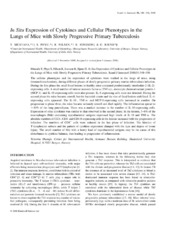In Situ Expression of Cytokines and Cellular Phenotypes in the Lungs of Mice with Slowly Progressive Primary Tuberculosis
Peer reviewed, Journal article
Permanent lenke
https://hdl.handle.net/1956/2065Utgivelsesdato
2000-06Metadata
Vis full innførselSamlinger
Originalversjon
https://doi.org/10.1046/j.1365-3083.2000.00721.xSammendrag
The cellular phenotypes and the expression of cytokines were studied in the lungs of mice, using immunohistochemistry, during different phases of slowly progressive primary murine tuberculosis infection. During the first phase the small focal lesions in healthy mice contained predominantly interleukin-2 (IL-2)- expressing cells. A small number of tumour necrosis factor-a (TNF-a)-, monocyte chemoattractant protein-1 (MCP-1)- and IL-10-expressing cells were also present. IL-4-expressing cells were not detected. During the second phase the mice became unwell, but the bacterial counts and the size of focal lesions stabilized. IL-4- expressing cells appeared. The IL-10-, TNF-a- and MCP-1-expressing cells increased in number. On progression to phase three, the mice became seriously unwell and died rapidly. The inflammation spread to <80% of the lung parenchyma. There was a marked increase in the number of IL-10-expressing cells. Expression of other cytokines was similar to that observed in the second phase. In the lesions, 3±6% of the macrophages (Mf) containing mycobacterial antigens expressed high levels of IL-10 and TNF-a. The absolute numbers of CD3-, CD4- and CD11b-expressing cells in the lesions increased with the progression of infection. The numbers of CD8+ cells were reduced in the last phase of infection. The kinetics of T-lymphocyte subsets and the pattern of cytokine expression changed with the type and degree of tissue injury. The small number of Mf with a heavy load of mycobacterial antigens may be the cause of this disturbance in cytokine balance, thus leading to progression of inflammation.
